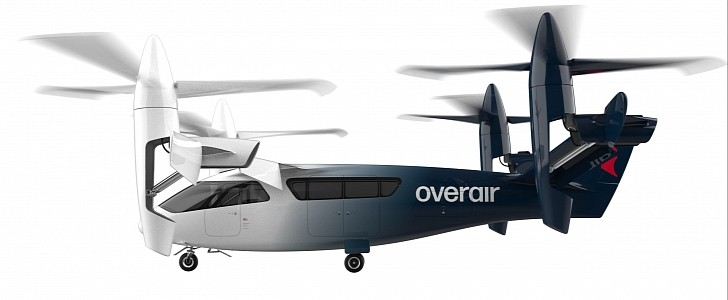Don’t let the name Butterfly fool you. This eVTOL (electric vertical take-off and landing) aircraft developed by Overair is nothing but fragile, boasting a military-inspired design, a proprietary propulsion system, and oversized propellers that help it fly in the most challenging conditions using just a fraction of the motor power. And we might see an experimental prototype of the flying machine in the sky next year.
Overair has worked assiduously to make its Butterfly known and put it in the sky, ever since 2018. With an extensive background in developing advanced flight vehicles in collaboration with the Department of Defense and NASA, Overair aims to now conquer the commercial market and redefine air transportation. Butterfly is the company’s first crack at giving life to “a new form of electric aerial mobility that is safe, sustainable, and equitable."
The aircraft is designed as an all-electric six-seater (five passengers and a pilot) that can take off and land vertically. It uses Overair’s proprietary propulsion system derived from military VTOL programs led by Abe Karem. He designs fixed and rotary-wing unmanned vehicles and is dubbed the founding father of drone technology.
The OSP (Optimum Speed Propulsion) system of the Butterfly uses four large propellers that spin slowly both when hovering and especially when cruising, drawing just a fraction of the available motor power, as explained by Overair. With such a slow speed of the propellers, the aircraft is as silent as a butterfly, boasting acoustic emissions that are below 40dB, which makes it perfect for operation in high-density areas with noise-sensitive communities.
In addition, the Butterfly has an increased payload capacity and can fly even in the most challenging weather conditions. The eVTOL has a cruise speed of 200 mph (322 kph) and can cover more than 100 miles (160 km) on a single battery charge.
With the recently received $145 million from ultra-precision communications and aircraft technologies developers Hanwha Systems and Hanwha Aerospace, Overair is getting one step closer to achieving its goal of soon flying its Butterfly. Well, not the production version, but an experimental prototype of the aircraft, which is scheduled to take to the skies in the second half of 2023.
Hanwha’s contribution doesn’t just limit to its generous investment either. The company will also provide electric motors and battery packs for Overair’s prototypes. Meanwhile, Overair continues to work towards receiving FAA (Federal Aviation Administration) certification. The eVTOL developer is also collaborating with NASA and Urban Movement Labs to bring the Butterfly to Los Angeles.
The aircraft is designed as an all-electric six-seater (five passengers and a pilot) that can take off and land vertically. It uses Overair’s proprietary propulsion system derived from military VTOL programs led by Abe Karem. He designs fixed and rotary-wing unmanned vehicles and is dubbed the founding father of drone technology.
The OSP (Optimum Speed Propulsion) system of the Butterfly uses four large propellers that spin slowly both when hovering and especially when cruising, drawing just a fraction of the available motor power, as explained by Overair. With such a slow speed of the propellers, the aircraft is as silent as a butterfly, boasting acoustic emissions that are below 40dB, which makes it perfect for operation in high-density areas with noise-sensitive communities.
In addition, the Butterfly has an increased payload capacity and can fly even in the most challenging weather conditions. The eVTOL has a cruise speed of 200 mph (322 kph) and can cover more than 100 miles (160 km) on a single battery charge.
With the recently received $145 million from ultra-precision communications and aircraft technologies developers Hanwha Systems and Hanwha Aerospace, Overair is getting one step closer to achieving its goal of soon flying its Butterfly. Well, not the production version, but an experimental prototype of the aircraft, which is scheduled to take to the skies in the second half of 2023.
Hanwha’s contribution doesn’t just limit to its generous investment either. The company will also provide electric motors and battery packs for Overair’s prototypes. Meanwhile, Overair continues to work towards receiving FAA (Federal Aviation Administration) certification. The eVTOL developer is also collaborating with NASA and Urban Movement Labs to bring the Butterfly to Los Angeles.







